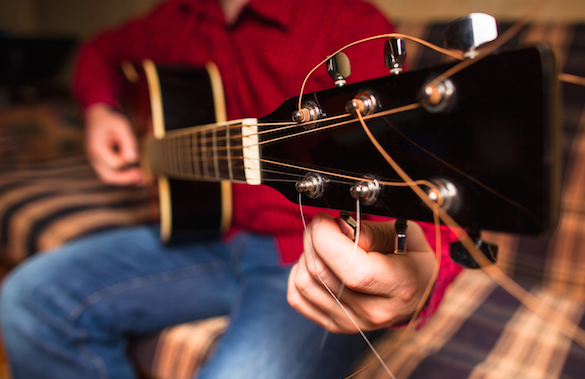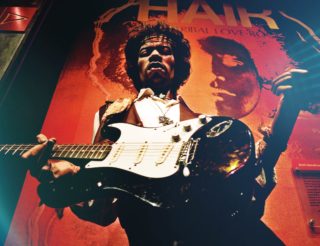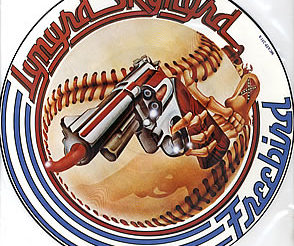Alternate Tunings
Author: Graeme Hague

The very first thing you’re taught beginning to learn guitar is how to tune the strings correctly. Your entire musical journey starts from there including understanding concert pitch (normally A440 Hz) so that you’re not only in tune, but in tune with everyone else. Back in the ol’ days you needed an accurate tuning fork or pitch pipe to give that all-important A above Middle C tone for a reference, before tuning the rest of your strings by ear. Unless you had a piano handy.
Now, of course, we have electronic tuners. I reckon the tuner in Uberchord is brilliant, not just because it’s very accurate, but also for its size on my iPad. If you’ve ever been on a dim stage between songs and trying to see an LCD tuner in the gloom, you’ll know exactly what I’m talking about.
Electronic tuners have also made it much easier to play your guitar using what’s called “alternate tunings”, which Uberchord introduced in one of its latest updates. Alternate tunings are cool and have been around a long time, but to be honest when you’re performing live it was always a bit of a head-scratcher trying to remember, in a hurry, the proper fretting to retune each string. Time-consuming, too. Alternate tunings sound great, but can be sort of a hassle if you only own one guitar. Unless you’re super-famous and can afford a different guitar on stage for every tuning you play.
Uberchord comes to the rescue making alternate tunings simple by letting you select the tuning you want and the app adjusts the in-built tuner accordingly along with displaying the required pitch of each string. For example, the Open D tuning that comes free with Uberchord tells us your strings should be tuned to D2 A2 D3 F#3 A3 D4 (relative to the standard E A D G B E) and the tuner resets itself to these. No more scribbled notes on what the tunings should be or what fretting you need for manual tunings.
So okay, perhaps you’re thinking that you haven’t progressed too far from learning the basic chords in standard tuning. What’s all the excitement about? Should you even care about alternate tunings yet?
Why Alternate Tunings?
There are several ways to look at alternate tunings. Something like the free Open D tuning lets you play any major chord you want with a single barred finger. Awesome! Chuck all those guitar lessons in the bin and go take the guitar world by storm — as long as all your songs are composed of major chords, obviously.
All right, let’s get serious and not forget about playing the blues and slide or pedal-steel guitars. The majority of slide guitar playing is done in alternate, open tunings and demands some real skills and musicianship. Slide playing is an art of its own.
For everyday guitar players the best approach is to discover the rich, open-string tones that alternate tunings can create and how comparatively simple fingering and fretting will achieve chords that are damned difficult in standard tuning. This also applies to finger-picking. Many picking techniques can sound dull, if you’re playing barre chords and your chord fretting isn’t perfect. An alternate tuning can offer easier chords and open strings that lend themselves to nice finger-picking.
However, the idea isn’t really to search through the alternate tunings for a better way to play a particularly vexing chord. Instead, you should experiment with all kinds of different chord shapes — two fingers will often be all you need — and listen to those cool sounds to unlock a whole new world of possibilities for your playing. And remember, using Uberchord’s Chord Finder feature, you can always find out exactly what you’re playing, because the app still hears and recognises chords in alternate tunings.
If you’re a novice player still struggling with basic chords, trying alternate tunings can be a welcome break and rekindle your enthusiasm. And it’s actually not a bad idea to begin investigating alternate tunings early in your guitar-playing career. Plenty of old-school players find it hard think outside of the “box” after years of playing standard tuning.
What Are Alternate Tunings?
For the record, strumming your guitar with open strings plays an A/11 chord, which is the kind of chord that jazz musicians play after drinking lots of beer.
The alternate tunings themselves tell us what’s going on — without the jazz. The Open D tuning means that if you play all your strings open — no fretting at all — your guitar plays a D Major chord. If you’ve got a bit of musical theory, knowing this might give you some ideas. For instance, detuning the fourth string a semi-tone to an F will give you an Open D Minor tuning… but bear in mind, changing the tuning sometimes won’t be as easy as tweaking just one string.
Mostly the name of the alternate tuning reveals the chord being played. There are other tunings that are named in such a way that describes what’s been done. Drop D tuning means the first E string is detuned a tone to D — used a lot by grunge bands in the nineties. Half Step Down or Whole Step Down (a “step” being a whole tone) are tunings that let you play familiar chords with a lower overall pitch, which might suit a vocalist or again it’s a grunge thing (or the tuning opposite to using a capo).
Celtic tuning is hugely popular, maybe used more than any other, and it’s better known by the actual tuning itself and called “DADGAD”.
These are all included in the nineteen different alternate tunings available for Uberchord — don’t forget the first, Open D, is free. You might be surprised to discover just how many of your favourite songs were composed in alternate tunings. Learning to play these can be a great way to demonstrate how the tunings can work. Here are five to get you started.
- Big Yellow Taxi: Joni Mitchell: Open D Tuning.
- Daughter: Pearl Jam: Open G Tuning.
- No Other Way: Jack Johnson: Drop D Tuning.
- Kashmir: Led Zeppelin: Celtic (DADGAD)
- Just Got Paid Today: ZZ Top: Open E Tuning
The Alternate Tuning feature in Uberchord is found in the “Tuner” window. Tap the arrow beside the standard tuning display and the full list of tunings is shown. Have fun!








No comments yet - be the first.